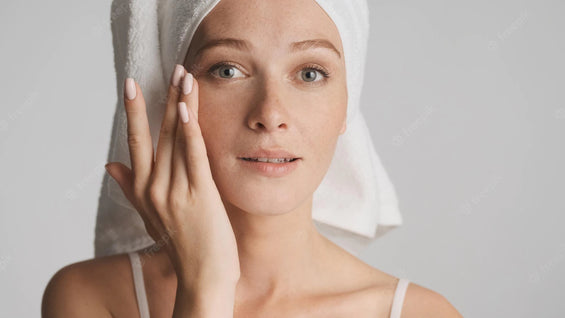
The Colourful World of Pigmentation
As featured in Beautify by ACSG.
Our skin is an extraordinary canvas of colours, shades, and tones. One of the most intriguing aspects of skin's beauty is pigmentation. Pigmentation refers to the colouration of our skin, and it is determined by melanin, a pigment produced by specialised skin cells called melanocytes. While pigmentation adds unique charm to our appearance, it can sometimes present challenges when it becomes uneven or appears in excess. In this article, we will explore the different types of pigmentation, how to identify them, ways to prevent pigmentation, and various skincare approaches to treat pigmentation-related concerns.
TYPES OF PIGMENTATION
Freckles
Freckles are clusters of small, flat, tan, or light brown spots that commonly appear on fair-skinned individuals, especially those with red or blonde hair, and tend to be genetic. The key factor in freckle formation is the overproduction of melanin, the pigment responsible for the colour of our skin, hair, and eyes. When the skin is exposed to ultraviolet (UV) rays from the sun, it triggers the melanocytes, specialised skin cells that produce melanin, to produce more pigment in specific areas. Freckles are not the result of an increase in the number of melanocytes but rather the increased activity of existing ones. They tend to darken with sun exposure and may fade during winter or with reduced sun exposure.
Sunspots
Sunspots are larger, darker spots that typically appear on areas frequently exposed to the sun, such as the face, hands, shoulders, and arms. Unlike freckles, sunspots are a consequence of long-term sun exposure rather than a genetic predisposition. The sun's UV rays lead to damage in the deeper layers of the skin, particularly the dermis. As a defence mechanism, melanocytes release more melanin to protect the skin from further damage. However, this process can result in the accumulation of melanin in localised areas, leading to the formation of sunspots. 
Melasma
Melasma is a pigmentation condition characterised by the appearance of brown or grey-brown patches on the face, primarily on the cheeks, forehead, nose, and upper lip. It is more common in women, and hormonal changes play a significant role in its development. During pregnancy or while taking hormonal medications like birth control pills, fluctuations in estrogen and progesterone levels can stimulate melanocytes to produce excess melanin. Sun exposure exacerbates melasma by activating melanocytes further. Additionally, genetics and ethnicity may contribute to one's susceptibility to melasma.
Post-Inflammatory Hyperpigmentation (PIH)
Post-Inflammatory Hyperpigmentation (PIH) occurs as a response to skin inflammation caused by acne, injuries, burns, or certain skin conditions. When the skin is injured or inflamed, it triggers an immune response, and inflammatory cells release chemical signals that activate melanocytes. As a result, these cells produce more melanin, leading to dark spots or patches that persist even after the initial cause of inflammation has healed. PIH can vary in intensity and duration, depending on the individual's skin type and the severity of the inflammation.
Vitiligo
Vitiligo is a unique pigmentation condition characterised by the loss of skin colour in patches. The exact cause of vitiligo is not fully understood, but it is believed to be an autoimmune disorder. In this condition, the body's immune system mistakenly attacks and destroys melanocytes in certain areas of the skin. As a result, these areas lose their ability to produce melanin, leading to depigmented white or light patches. Vitiligo can affect people of all ethnic backgrounds and is not caused by sun exposure.Identifying pigmentation types is crucial for effective treatment. If you notice any unusual changes in your skin, it's essential to consult your clinician for an accurate diagnosis and treatment recommendation. If there are any further concerns a dermatologist can also differentiate between harmless pigmentation and more serious skin conditions. Understanding the science behind different types of pigmentation helps us appreciate the intricate workings of our skin and the factors that influence its appearance. While some pigmentation concerns may be genetically determined, others can be managed and prevented with adequate sun protection and skincare.
TREATING PIGMENTATION WITH SKINCARE
While complete eradication of some pigmentation types may not be possible, various skincare approaches can significantly improve their appearance. Addressing various types of pigmentation requires a multifaceted approach that combines targeted skincare products and professional treatments. Here are some common treatments and products that can help with different types of pigmentation:
Topical brightening agents:
Topical brightening agents contain ingredients that help visibly improve pigmented spots by reducing the appearance of melanin accumulation and promoting even skin tone.
Some key ingredients include:

Retinoids
Topical retinoids, derivatives of Vitamin A, are not only effective for managing blemish-prone skin and promoting skin renewal but can also help fade sunspots and PIH over time. Retinoids work by increasing cell turnover and promoting the shedding of pigmented skin cells. Three prominent types of retinoids commonly used for addressing pigmentation concerns are Retinol, Retinaldehyde, and Retinoic Acid. Retinol is a mild variant, which the skin converts into Retinaldehyde, a more potent form. Retinaldehyde, in turn, is converted into Retinoic Acid, the active and most potent form of vitamin A. Retinoic Acid offers the most potent effects on pigmentation, promoting skin cell turnover, and reducing the appearance of dark spots and uneven skin tone. While Retinol and Retinaldehyde are gentler options suitable for sensitive skin types, Retinoic Acid requires closer supervision due to its increased potency.
Sun Protection
An essential component in any pigmentation treatment plan. It helps protect the skin from harmful UV rays that trigger melanin production and can worsen existing pigmentation issues. Broad-spectrum sun protection with SPF 30 or higher should be used daily, even on cloudy days, and reapplied throughout the day.
IN-CLINIC TREATMENT OPTIONS
Chemical Peels
Chemical peels are versatile and effective treatments for various skin concerns, including pigmentation issues. During the procedure, a chemical solution is applied to the skin, causing controlled exfoliation of the outermost layer. This process removes dead skin cells, revealing fresher, brighter skin underneath. Chemical peels containing alpha hydroxy acids (AHAs) like glycolic acid or beta hydroxy acids (BHAs) like salicylic acid are often used to target pigmentation. These peels can help fade dark spots, sunspots, and melasma, resulting in a more even skin tone. The depth and intensity of the peel can be adjusted based on the specific skin concern and individual skin type. After the treatment, the skin may appear red and flaky, but this usually resolves within a few days to a week, leaving behind a revitalised and brighter complexion.
Laser Therapy
Laser treatments, such as fractional laser and intense pulsed light (IPL), utilise focused light energy to target pigmented areas in the skin. The energy is absorbed by the melanin in the pigmented cells, causing them to break down and be gradually absorbed by the body. This process leads to a reduction in pigmentation and the appearance of more even-toned skin. Laser therapy also stimulates collagen production, which helps improve skin texture and elasticity. The number of sessions required depends on the severity of pigmentation, but people often notice visible improvement after a few sessions. Mild redness and swelling may occur after the procedure, but downtime is minimal, and you can resume regular activities shortly after treatment. Laser treatments, such as fractional laser or intense pulsed light (IPL), can effectively target and break down pigmented areas in the skin. These treatments promote collagen production, leading to a brighter and more uniform skin tone.
Cryotherapy
Cryotherapy involves the use of extreme cold to target and destroy pigmented cells. This treatment is particularly useful for treating specific areas of hyperpigmentation, such as dark spots or age spots. The cold temperature causes the pigmented cells to freeze and eventually slough off, revealing lighter and more evenly toned skin. Cryotherapy is a quick procedure with minimal discomfort and downtime.
Microneedling
Microneedling, also known as collagen induction therapy, is a popular treatment for various skin concerns, including pigmentation issues. It involves using a device with tiny needles to create controlled micro-injuries in the skin's surface. These micro-injuries trigger the body's natural healing process, stimulating collagen and elastin production. As the skin heals, it becomes rejuvenated and appears brighter with improved texture. Microneedling can be combined with topical serums or growth factors to enhance the treatment's effectiveness in targeting pigmentation. The procedure is well-tolerated, and downtime is usually minimal, with some redness and mild swelling that subside within a few days.
Specialised Treatments
Clinics today offer a diverse array of specialised skin treatments, catering to individual needs and concerns. Innovations like cosmelean and WiQo One have emerged as noteworthy options in the realm of skincare. With a commitment to personalised care, clinics harness the potential of these treatments to provide clients with enhanced confidence through targeted and scientifically driven skincare interventions.
Remember that patience is key when treating pigmentation concerns, as results often take time to show. It's essential to follow a consistent skincare routine and protect your skin from sun exposure throughout the treatment process. It's crucial to note that pigmentation concerns can be complex and vary from person to person. For effective and safe treatment, it's best to consult with a qualified clinician who can provide personalised recommendations based on individual skin type, pigmentation severity, and certain medical history. Through a consultation, they may also make use of a skin analysis device to view the underlying causes and provide an accurate diagnosis to form a treatment program. Combining professional treatments with a consistent skincare routine and sun protection is the key to achieving a more even and radiant complexion.













